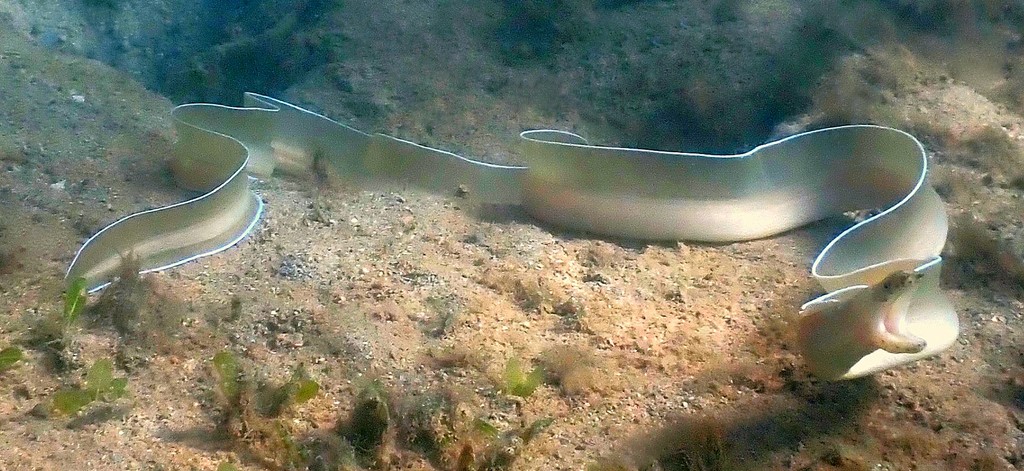PSEUDECHIDNA BRUMMERI - (BLEEKER, 1858)
Picture courtesy of: Amaury Durbano
Actinopterygii (Gigaclass) > Actinopteri (Class) > Teleostei (Subclass) > Elopomorpha (Superorder) > Anguilliformes (Order) > Muraenoidei (Suborder) > Muraenidae (Family) > Muraeninae (Subfamily) > Pseudechidna (Genus)
Murène ruban blanc, Murène à ruban blanc, Murène de Brummer, Brummer's moray, White ribbon eel, White ribbon moray, Ghost eel, Ribbon moray, Moyou-take-utsubo, モヨウタケウツボ, 布氏弯牙海鳝, 布氏長鯙,
Synonymes
Gymnothorax megapterus (Weber, 1913)
Muraena brummeri (Bleeker, 1858)
Muraena taenioides (Günther, 1872)
Pseudechilna brummeri (Bleeker, 1858)
Pseudechina brummeri (Bleeker, 1858)
Pseudoechidna brummeri (Bleeker, 1858)
Strophidon brummeri (Bleeker, 1858)
Strophidon polyodon (Bleeker, 1864)
------------------------
Description
Vertebrae: predorsal: 4-7, preanal: 89-98, total: 201-214; Preanal length: 2.1-2.3 in TL; Head long: 11-16 in TL; Body depth at gill opening: 39-56 in TL, and body depth at anus: 43-75 in TL. Snout length: 6.4-9.0 in HL, upper jaw: 3.4-4.2 in HL, and eye diameter: 12-22 in HL. Teeth moderate, variable; Intermaxillary teeth in 2-3 rows, with 3 moderate median teeth in juveniles and females, no median teeth in adult males; Maxillary teeth biserial anteriorly in juveniles and females, uniserial and few in males; Vomerine teeth few, staggered; Dentary teeth biserial anteriorly in juveniles and females, uniserial in males. Body and tail slender and elongate; dorsal-fin origin before gill openings; Anus before midlength. Teeth moderately sized and sexually dimorphic. Max. length: 103.0 cm TL. Depth range: 1 - 8 m.
Color
Body evenly pale tan to slightly yellowish, and fins with bright white margins; Top and sides of head conspicuously scattered with small black dots; Anterior nostrils black distally, posterior nostrils and head pores with black rims.
Etymology
Pseudechidna: from Greek, pseudes = false + from Latin, echidna = viper or adder. Although this genus may resemble Echidna, such an appearance is false.
brummeri: in honor of Lieutenant Colonel O. Brummer, military surgeon, Royal Dutch East Indies Army, who collected holotype.
Original description: Muraena brummeri Bleeker, 1858 - Type locality: Atapupu, Timor Island, southern Malay Archipelago.
Distribution
Indo-West Pacific: East Africa, Seychelles, Mayotte (France) and Madagascar, east to Cook Islands, north to southern Japan, south to northern Queensland (Australia) and New Caledonia.
Biology
Inhabits reef flats and shallow lagoons, usually buried in the sand or rubble. Occasionally seen swimming between its burrows in shallow protected areas. A gonochoristic species. Solitary.
Similar species
Gymnothorax albimarginatus (Temminck & Schlegel, 1846) - Reported from New Caledonia.
Gymnothorax albimarginatus (Temminck & Schlegel, 1846) - Reported from New Caledonia.
Gymnothorax griseus (Lacepède, 1803) - Reported from Red Sea; Western Indian Ocean: Transkei and KwaZulu-Natal (South Africa) and East Africa to Seychelles, Mayotte (France), Madagascar and Mascarenes (La Réunion, Mauritius, Rodrigues).
Rhinomuraena quaesita (Garman, 1888) - Reported from New Caledonia - Link to the species (here).
Last update: 1, April 2024
Last update: 1, April 2024
